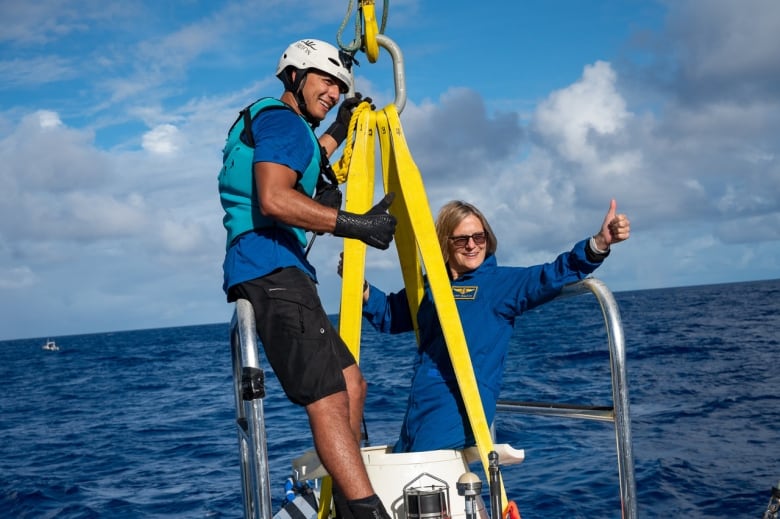1st U.S. woman to walk in space becomes 1st woman to visit ocean's deepest depths
Astronaut Kathy Sullivan is the first human to visit both space and the Challenger Deep

Kathy Sullivan says the biggest difference between ascending into space and descending to the deepest known part of the ocean is probably the view.
The former NASA astronaut and oceanographer has become the only human being to ever experience both extremes, according to EYOS Expeditions, which helped organize the historic event last week.
"There's a line of sight, the grand vista that you have up in orbit. You've got light all around you, air and vacuum. You can see vast distances. You can see both huge panoramic sweeps that give you a sense of context and connection you would never have in an earthly experience," Sullivan, 68, told As It Happens host Carol Off.
"In the deep sea, of course, it's quite dark."
Making history — again
Sullivan made history in 1984 with NASA, when she became the first U.S. woman to complete a spacewalk. Then last week, she made history again, this time as the first woman to visit the deepest known part of the ocean called Challenger Deep.
"The magical reason that you can do it — it's not really magic at all — is the wonders of engineering. That it's possible we have the know-how, the wherewithal, the materials to build something, a spacesuit or a submersible, that lets you be in a place that otherwise you have absolutely no business being," she said.
"There's the hard vacuum of space, nothing to breathe, no pressure to keep your body intact, or there's the immense pressure of the deep sea."

It's important, she says, to explore both because "there is still so much we don't know" about our world.
"A quest to explore, to go see or understand or find something that no one has done before, to push past some barrier, that grows and catalyzes both human development and technological development," Sullivan said.
"I look back at the Apollo program and I think it was vastly more than just get to the moon and say, 'Ta da, I got there!' It catalyzed an incredible array of dramatic advances in human biology, in health, physiology and digital computers."
As an astronaut, Sullivan logged 532 hours in space and was inducted into the Astronaut Hall of Fame in 2004.
She left NASA in 1993, and later went on to work at the National Oceanic and Atmospheric Administration — an institution she led under the Obama administration.
Her recent underwater excursion came at the invitation of Victor Vescovo, a former naval officer and wealthy investor with a passion for adventure.

On June 8, the pair climbed aboard his two-person submersible and descended about 10,900 metres into the murky waters. Hours later, after returning to the submersible's mothership, the team made a call to the International Space Station.
"We made some more history today … and then got to share the experience with kindred spirits in the ISS," Vescovo said in a press release.
"It was a pleasure to have Kathy along both as an oceanographer during the dive, and then as an astronaut to talk to the ISS."
A few days later, mountaineer Vanessa O'Brien took the same trip with Vescovo, becoming the second woman to visit Challenger Deep, reports the New York Times.

Sullivan described watching the world change around her during the four hours it took them to reach the ocean floor.
"There's a few minutes … where you're still on that lovely turquoise, tropical blue of tropical ocean," she said.
"Then slowly, as the light dissipates and phases out, it gets to a deep, dark royal blue, and then eventually just to no light at all."
While it's a stark contrast to the bright lights and spectacular views of space, Sullivan says there's an important trade-off.
"The compensation for not having that vast vista is the ocean is so magically alive," she said. "Everywhere you look, it's just wondrous."
Written by Sheena Goodyear. Interview produced by Katie Geleff.
